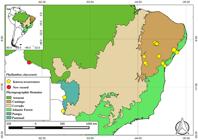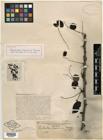ABSTRACT
The first record of Phyllanthus chacoensis for the Brazilian Amazon is presented, based on a specimen from Rondônia state. The species can be recognized by its cauliflorous inflorescence, staminate and pistillate flowers with 4 sepals, devoid of a floral disk, 4 stamens, 2-carpellary ovary, drupaceous, ellipsoidal fruits, with one seed per locule. The species was previously known only from the central-western and northeastern regions of the Caatinga and Pantanal domains in Brazil. We provide a list of synonyms, a detailed description, an updated geographic distribution map in Brazil, data on habitat and conservation status, illustrations of its reproductive characters, and detailed photographs. We also propose a lectotype for the species.
KEYWORDS:
Neotropics; nomenclature; northern Brazil; taxonomy
RESUMO
Apresentamos o primeiro registro de Phyllanthus chacoensis para a Amazônia brasileira, baseado em um espécime encontrado em Rondônia. A espécie pode ser reconhecida pela inflorescência cauliflora, flores de ambos os sexos com 4 sépalas, desprovidas de disco floral, 4 estames, ovário 2-carpelar e frutos elipsoides, drupáceos, com uma semente por lóculo. No Brasil, a espécie era referida, até o momento, apenas para as regiões Centro-Oeste e Nordeste nos domínios Caatinga e Pantanal. Apresentamos a lista de sinônimos, descrição morfológica detalhada, um mapa atualizado da distribuição geográfica no Brasil, dados sobre habitat e status de conservação, assim como fotos em campo e ilustração dos caracteres reprodutivos. Adicionalmente, propomos um lectótipo para o nome.
PALAVRAS-CHAVE:
Neotrópicos; nomenclatura; norte do Brasil; taxonomia
INTRODUCTION
The Amazonian lowland rainforest is home to almost 190 plant families, of which Phyllanthaceae is represented by 55 species from eight genera (Amanoa Aubl., Chonocentrum Pierre ex Pax & K.Hoffm., Didymocistus Klotzsch, Hyeronima Allemão, Jablonskia G.L.Webster, Margaritaria L.f., Phyllanthus L., and Richeria Vahl) (Cardoso et al. 2017; Flora do Brasil 2020 [under construction]). The Brazilian Amazon is the third biome in terms of Phyllanthus diversity, with 33 species, after the Atlantic Forest (52 species) and Cerrado (43) (Flora do Brasil 2020 [under construction]). Phyllanthus has a cosmopolitan distribution, with 880 species globally, of which over 200 occur in the Neotropics; 90 to 110 species have been recorded for Brazil in all vegetation types (Webster 2002; Kathriarachchi et al. 2006; Silva and Sales 2007; Bouman et al. 2018; Flora do Brasil 2020 [under construction]).
The species richness of the genus in Brazil is almost certainly underestimated, since the last major revision was published in the Flora Brasiliensis by Müller Argoviensis in 1873 and included 71 species. More recently, floristic studies by Webster (2002) and Silva and Sales (2007) made important contributions to the understanding of the morphology of several taxa. The floristic knowledge of the Amazon basin is even more precarious, as pointed out by Hopkins (2005) and Ter Steege et al. (2013) and, consequently, the diversity of Phyllanthus in the region is probably underestimated, as exemplified here with the recognition of a new record of a Phyllanthus tree species in the Brazilian Amazon, Phyllanthus chacoensis Morong.
Taxonomic advances in the Amazon region are hampered by low numbers of herbaria and deposited specimens, low collection rates, and relatively few specialized taxonomists (Barbosa et al. 2003), which helps explain the relatively few studies and the low capacity for determining the real diversity of Phyllanthus (e.g.,Rodrigues 1971; Webster 2004; Secco 2013; Secco and Rosário 2015; Secco and Silveira 2016). Additionally, Phyllanthus is one of the most morphologically complex groups of Phyllanthaceae due to its variable habits (herbs to trees), phyllanthoid or non-phyllanthoid branching, and tiny gamosepalous pistillate flowers with disks commonly entire, and disks segmented and alternisepalous in staminate flowers (Silva and Sales 2004, 2007).
As a result of increased collection efforts and extensive analyses of herbarium specimens as part of a revision of Phyllanthus conducted by the first author, an indeterminate specimen (with duplicates deposited at INPA, NY and RB herbaria) that had been collected 58 years ago in what is now Rondônia state (northern Brazil) was encountered. We identified the collection as P. chacoensis, representing a new record for the Amazonian flora. In addition to the description of the new record, we propose its lectotypification and discuss its conservation status.
MATERIAL AND METHODS
Specimens of Phyllanthus chacoensis deposited in collections at the INPA, NY and RB herbaria were identified based on the types stored at CORD, F, G, GH, K, MICH, MO, MPU, NDG, NY, P, PH, UC and US (acronyms according to Thiers 2020, updated continuously) and compared with information published by Silva and Sales (2007, 2008) and Melo et al. (2013). Data concerning their geographic distributions were obtained from herbarium labels and from the aforementioned literature. The descriptive terminology follows Silva and Sales (2007), complemented by Radford et al. (1974). The typification was based on the rules of International Nomenclature (Turland et al. 2018). Maps were prepared using QGIS 2.3 software, based on data from geographic coordinates from herbarium labels, or estimated from locality data. The conservation status of the species was reevaluated according to the IUCN methodology and the IUCN Red List Categories and Criteria (IUCN 2012), using the Geocat web tool (http://geocat.kew.org/), following Bachman et al. (2011).
RESULTS
Phyllanthus chacoensis Morong, Ann. New York Acad. Sci.7: 218. 1892. Aporosella chacoensis (Morong) Speg., Cat. Descr. Maderas 349. 1910. Type: PARAGUAY. Gran Chaco, Asunción, T. Morong 355 (lectotype designated here NY00273054!; isolectotypes CORD00003196!, F0057015F!, G00307040!, GH00048576!, K000573219!, MICH1104948!, NDG29188!, NY00579396!, NY00273055!, NY00273056!, PH00031117!, US00109220!, US00997721!).
= Aporosella hassleriana Chodat, Bull. Herb. Boissier, II. 5: 489. 1905. Type: PARAGUAY. Concepción, E. Hassler 7161 (lectotype G00229904!, designated by Ramella & Zuloaga 2017: 404; isolectotypes [negative F0BN005009!], G00229906!, G00229907!, G00229911!, G00229912!, MO260328!, MPU014790!, MICH1107950!, NY00246237!, P00608946!, P00608947!, P00608948!, P00608949!, UC941632!).
= Sebastiania singularis Rizzini, Leandra 3-4(4-5): 7. 1974. Type: BRAZIL. Bahia. Casa Nova: crescit in caatinga ad Casa Nova, F.B. Ramalho 190 (holotype RB00549688!, isotypes HST4106!, HUCPE611!, PEUFR37471!).
Tree 2-6 m high (Figure 1a), monoecious. Branching phyllanthoid, glabrous, reddish; branches 6-20 cm long, angular, lenticellate, brown. Cataphylls ca. 2 mm long, widely triangular, membranous; cataphyllary stipules, triangular-ovate, ca. 1.5 mm long, with fimbriate margins. Stipules 1-1.5 mm long, triangular, margins fimbriate. Petiole ca. 2 mm long, glabrous. Leaf blade 1.5‒2.5 × 1‒2.5 cm (Figure 1b), green-opaque, chartaceous, widely elliptic to orbicular or obovate; base obtuse; apex rounded to retuse; glabrous; margins slightly denticulate, with the presence of glands in the indentations; venation brochidodromous. Inflorescences cauliflorous, 3‒4 cm long, thyrseform (Figure 1c, d), unisexual, peduncle ca. 4 mm long, glabrous; staminate thyrse 9 to 12-cymules, each cymule with 3 flowers; pistillate thyrse with 8‒10 cymules, each cymule with 1 to 2-flowers; staminate and pistillate cymules each subtended by a bract, oval-deltoid, acuminate, each flower surrounded by a lanceolate bracteole. Staminate flowers (Figure 1f), ca. 2 mm long, pinkish or green; pedicel 1-2 mm long, glabrous; sepals 4, 1‒1.5 mm long, oblong-spatulate, rounded at the apex, margins entire to slightly fimbriate; disk absent; stamens 4, subsessile, free, anthers oblong, vertically dehiscent. Pistillate flowers (Figure 1g), 1‒2 mm long, pinkish or green: pedicel ca. 3 mm long, glabrous; sepals 4, 0.8‒1.5 mm long, oblong-spatulate, rounded at the apex, margins entire to slightly fimbriate; disk absent; ovary ca. 0.6‒0.8 mm long, ellipsoidal, reddish; 2-locular, with 1 ovule per locule; styles connate at the base, deeply bifid, curved downward. Fruits drupaceous, 6‒8 × 4‒5.2 mm (Figure 1e, h), green, ellipsoidal, with sepals and styles persistent; fruit pedicel 4‒6 mm long. Seeds 3‒5 × ca. 4 mm, subglobose, grayish-brown, smooth to slightly wrinkled.
Phyllanthus chacoensis. A − Habit; B − Leaf blade; C and D − Cauliflorous inflorescence (with details of the flowers in D); E − Fruits; F − Staminate flower; G − Pistillate flower; H − Drupaceous fruit, ellipsoidal, with persistent sepals and styles. A, B, D and E: images provided by Paraguay Biodiversity; C: E. Hassler (7161); F, G and H: drawing by Regina Carvalho. This figure is in color in the electronic version.
Representative specimens examined: Brazil. Alagoas: Traipu, 18.II.2014 (fr.), E. Melo et al. 12421 (HUEFS, P). Bahia: Morpará, 15.XII.2007 (fl., fr.), A.A. Conceição et al. 2638 (HUEFS). Mato Grosso do Sul: Corumbá, 15.IX.1989 (fl., fr.), A. Pott et al. 4936 (SP, CPAP). Pernambuco: Petrolina, 15.III.1983 (fl., fr.), Fotius 3652 (IPA). Rondônia [new record]: Forte Príncipe da Beira, 6.I.1962 (fl.), W.A. Rodrigues & B.W.P. Albuquerque 4256 (INPA10822, NY01461186, NY01461187). Sergipe: Neópolis, 19.II.2014 (fr.), E. Melo et al. 12458 (HUEFS, P).
Distribution and habitat: Exclusive to South America, recorded in Argentina, Paraguay, and Brazil. In Brazil, it was previously known from northeastern (Alagoas, Bahia, Pernambuco, Sergipe) and midwestern (Mato Grosso do Sul) states (Lourteig and O’Donell 1942; Silva and Sales 2007; Secco et al. 2018, Flora do Brasil 2020 [under construction]). The distribution of P. chacoensis is expanded here to the northern region of that country (the Brazilian Amazon; Figure 2). The new record was found along the margins of an igapó (seasonally inundated forest), which confirms the species’ preference for swampy or riparian environments.
Geographic distribution of Phyllanthus chacoensis in Brazil, including the new record. This figure is in color in the electronic version.
Conservation status: According to IUCN (2012) criteria, the species is classified as endangered (EN) - ENB1ac (iii), as it has an extent of occurrence (EEO) of 204,000 km2 (including the new record). Phyllanthus chacoensis should therefore be the target of collection efforts to assist in the selection of priority areas for its conservation. Most of the collected specimens in Brazil were encountered in riparian vegetation, such as along the banks of the São Francisco River (northeastern region), the Paraguay River (midwestern region), and Guaporé River (northern region), which suffer from constant anthropic impacts, including dense urban occupation and the discharge of untreated domestic sewage, resulting in biodiversity loss.
Taxonomic notes: Thomas Morong (1892) described Phyllanthus chacoensis based on syntypes “In the Gran Chaco, opposite Asuncion (355)”. = Balansa 1712, Fendler Panama 140, Fendler 323”. The collection Morong 355 is the most likely to have been used by the author in the description. However, four specimens were found in the author’s main herbarium (NY). The material selected as a lectotype is deposited under registration (NY00273054; Figure 3), as it is the best conserved and has flowers of both sexes.
Lectotype of Phyllanthus chacoensis at NY (NY00273054). Reproduced with the permission of the curator of The New York Botanical Garden. This figure is in color in the electronic version.
DISCUSSION
The Amazon region represents a distinct phytogeographic province characterized by a humid tropical forest of enormous biomass, heterogeneity, and diversity (Braga 1979). Collection efforts such as the “Projeto Flora Amazônica (CNPq/NSF)”, initiated in 1976 (Secco 2018), have made significant progress in increasing our knowledge of the flora of the Brazilian Amazon, with many expeditions and a large number of plant specimens deposited in regional herbaria (with duplicates distributed among national and international herbaria). However, considering the extent of the region, the collection rate in the region is still the lowest in Brazil (Hopkins 2019). The new record of P. chacoensis for the Brazilian Amazon reinforces the importance of these botanical collections, as the species had not been collected in the region since 1962. We have not found any more recent collection in the region. However, collections of P. chacoensis are much more numerous in northeastern and central-western Brazil (ca. 33 and six specimens respectively), collected since 1984.
Phyllanthus chacoensis is the only species in the subsection Aporosella (Chodat) G.L. Webster (P. sect. Cicca (L.) Müll.Arg. and P. subg. Kirganelia (A.Juss.) Kurz) (Webster 1957, 2001; Bouman et al. 2018), and can be differentiated from other Brazilian species by the absence of a floral disk in staminate and pistillate flowers, and by having four sepals and stamens, cauliflorous inflorescences, a 2-carpellar ovary, and fruits with one seed per locule (Silva and Sales 2007; Melo et al. 2013). Phyllanthus chacoensis is morphologically similar to P. elsiae Urb., which is found in Argentina (Silva and Sales 2007), although the former can be distinguished by being monoecious (vs dioecious in P. elsiae), by having a 2-locular ovary (vs 3-locular), styles deeply 2-fid, curved downwards (vs joined in a column and descending) and ellipsoidal fruits (vs oblate-spheroidal).
CONCLUSIONS
A new record of Phyllanthus chacoensis in the Brazilian Amazon expands the distribution of the species in Brazil and confirms its preference for swampy habitats close to water bodies. It also reinforces the need for investments in botanical collections in northern Brazil, especially in the Amazon region, as well as the training of specialized human resources, as the specimen examined here had lain for more than 50 years in a herbarium without being identified. The conservation status of P. chacoensis, associated with its occurrence in highly threatened sites, indicates the need to protect this species.
ACKNOWLEDGMENTS
The authors thank the Conselho Nacional de Desenvolvimento Científico e Tecnológico (CNPq) for the grant to the first author and for the productivity grant to Margareth Sales; Wesley Cordeiro for making the map; and the organization Paraguay Biodiversity for the images
REFERENCES
- Bachman, S.; Moat, J.; Hill, A.W.; Torre, J.; Scott, B. 2011. Supporting red list threat assessments with GeoCAT: Geospatial conservation assessment tool. ZooKeys, 150: 117-126.
- Barbosa, M.R.V.; Peixoto, A.L. 2003. Coleções botânicas brasileiras: situação atual e perspectivas. In: Peixoto, A.L. (Org.). Coleções Biológicas de Apoio ao Inventário, Uso Sustentável e Conservação da Biodiversidade Instituto de Pesquisas Jardim Botânico do Rio de Janeiro, Rio de Janeiro, p.113‒125.
- Bouman, R.W.; Keβler, P.J.A.; Telford, I.R.H.; Bruhl, J.J.; Welzen, P.C. van. 2018. Subgeneric delimitation of the plant genus Phyllanthus (Phyllanthaceae). Blumea, 63: 167‒198.
- Braga, P.I.S. 1979. Subdivisão fitogeográfica, tipos de vegetação, conservação e inventário florístico da floresta amazônica. Acta Amazonica, 9: 53‒80.
- Cardoso, D.; Särkinen, T.; Alexander, S.; Amorim, A.M.; Bittrich V.; Celis, M.; et al 2017. Amazon plant diversity revealed by a taxonomically verified species list. Proceedings of the National Academy of Sciences, 114: 10695‒10700.
-
Flora do Brasil. 2020. [under construction]. ( (https://floradobrasil.jbrj.gov.br/ ). Accessed on 03 Feb 2020.
» https://floradobrasil.jbrj.gov.br/ - Hopkins, M.J.G. 2005. Flora da Reserva Duke, Amazonas, Brasil. Rodriguésia, 56: 9‒25.
- Hopkins, M.J.G. 2019. Are we close to knowing the plant diversity of the Amazon? Anais da Academia Brasileira de Ciências (online), 91: e20190396.
- IUCN. 2012. The IUCN Red List Categories and Criteria: Version 3.1. 2nd ed. Gland and Cambridge, 32p.
- Kathriarachchi, H.; Samuel, R.; Hoffmann, P.; Mlinarec, J.; Wurdack, K.J.; Ralimanana, H.; Stuessy, T.F.; Chase, M.W. 2006. Phylogenetics of tribe Phyllantheae (Phyllanthaceae; Euphorbiaceae sensu lato) based on nrITS and plastid matK DNA sequence data. American Journal of Botany, 93: 637-655.
- Lourteig, A.; O’Donell, C.A. 1942. Euphorbiaceae Argentinae-Phyllantheae, Dalechampieae, Cluytieae e Manihotieae. Lilloa, 9: 77‒173.
- Melo, A.L.; Silva, M.J.; Sales, M.F. 2013. Sebastiania singularis (Euphorbiaceae): um novo sinônimo para Phyllanthus chacoensis (Phyllanthaceae). Rodriguésia, 64: 665‒666.
- Müller, J. 1873. Euphorbiaceae, Phyllantheae. In: Von Martius, C.F.P. (Ed.). Flora Brasiliensis 11. Oldenbourg, Munich & Leipzig, p.7-80.
- Radford, A.E.; Dicknson, W.C.; Massey, J.R.; Bell, C.R. 1974. Vascular Plant Systematics Harper & Row Publishers, New York, 891p.
- Ramella, L.; Zuloaga, F.O. 2017. Typification of Aporosella hassleriana Chodat (Phyllanthaceae) of the flora of Paraguay. Candollea, 72: 403‒404.
- Rodrigues, W.A. 1971. Novo Phyllanthus (Euphorbiaceae) da Amazônia Brasileira. Acta Amazonica, 2: 17‒18.
- Secco, R.S. 2013. A new infraspecific taxon of Phyllanthus myrsinites (Phyllanthaceae) from the Brazilian Amazon. Phytotaxa, 142: 51-54.
- Secco, R.S. 2018. A Coordenação de Botânica do Museu Paraense Emílio Goeldi no decorrer de 150 anos da instituição. Boletim do Museu Paraense Emílio Goeldi, Ciências Naturais, 13: 261‒269.
- Secco, R.S.; Rosário, A.S. 2015. A new species of Phyllanthus (Phyllanthaceae) endemic to Amazonas state, Brazil. Novon, 24: 209-211.
- Secco, R.S.; Silveira, J.B. 2016. Flora das cangas da Serra dos Carajás, Pará, Brasil: Phyllanthaceae. Rodriguésia, 67: 1437‒1442.
- Secco, R.S.; Bigio, N.C.; Cordeiro, I.; Pscheidt, A.C.; Marques, O.; Caruzo, M.B.R. 2018. Check-list de Euphorbiaceaes. str., Phyllanthaceae e Peraceae de Mato Grosso do Sul, Brasil. Iheringia, Série Botânica, 73: 207‒215.
- Silva, M.J.; Sales, M.F. 2004. O gênero Phyllanthus L. (Phyllantheae - Euphorbiaceae Juss.) no bioma Caatinga do estado de Pernambuco - Brasil. Rodriguésia, 55: 101‒126.
- Silva, M.J.; Sales, M.F. 2007. Phyllanthus L. (Phyllanthaceae) em Pernambuco, Brasil. Acta Botanica Brasilica, 21: 79-98.
- Silva, M.J.; Sales, M.F. 2008. Sinopse do gênero Phyllanthus (Phyllanthaceae) no Nordeste do Brasil. Rodriguésia, 59: 407‒422.
- Ter Steege, H.; Pitman, N.C.A.; Daniel, S.; Baraloto, C.; Salomão, R.P.; Andino, J.E.G.; et al 2013. Hyperdominance in the Amazonian tree flora. Science, 342: 1243092.
-
Thiers, B. 2020. [continuously updated] Index Herbariorum: A global directory of public herbaria and associated staff. New York Botanical Garden’s Virtual Herbarium. ( (http://sweetgum.nybg.org/science/ih/ ). Accessed on 29 Feb 2020.
» http://sweetgum.nybg.org/science/ih/ - Turland, N.J.; Wiersema, J.H.; Barrie, F.R.; Greuter, W.; Hawksworth, D.L.; Herendeen, P.S.; et al 2018. International Code of Nomenclature for algae, fungi, and plants (Shenzhen Code) adopted by the Nineteenth International Botanical Congress Shenzhen, China, July 2017. Regnum Vegetabile 159. Koeltz Botanical Books, Glashütten, 254p.
- Webster, G.L. 1957. A monographic study of the West Indian species of Phyllanthus Journal of the Arnold Arboretum, 38: 51-80,170-198, 295-373.
- Webster, G.L. 2001. Synopsis of Croton and Phyllanthus (Euphorbiaceae) in western tropical Mexico. Contributions from the University of Michigan Herbarium, 23: 353‒388.
- Webster, G.L. 2002. A Synopsis of the Brazilian taxa of Phyllanthus section Phyllanthus (Euphorbiaceae). Lundellia, 5: 1-26.
- Webster, G.L. 2004. A revision of Phyllanthus section Hylaeanthus (Euphorbiaceae). Lundellia, 7: 11‒27.

 Phyllanthus chacoensis (Phyllanthaceae): new record for the Brazilian Amazon and its lectotypification
Phyllanthus chacoensis (Phyllanthaceae): new record for the Brazilian Amazon and its lectotypification






